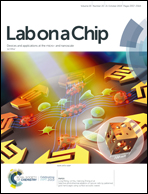Drag controlled formation of polymeric colloids with optical traps†
Abstract
Optical trapping is a powerful optical manipulation technique for controlling various mesoscopic systems that allows formation of tailor-made polymeric micro-sized colloids by directed coalescence of nucleation sites. However, control over the size of a single colloid requires constant monitoring of the growth process and deactivation of the optical trap once it reaches the required dimensions. Moreover, producing more than one colloid requires moving the sample to a pristine location where the process must be repeated. Here, we present a novel method for continuous control over formation of polydimethylsiloxane colloids based on directed coalescence induced by optical traps under flow inside microfluidic channels. Once the drag force on a growing colloid exceeds the trapping force, it leaves the optical trap, and a new colloid starts to form at the same location. We demonstrate repeatability of the process and selectively produce colloids with radii of ∼1–14 μm by controlling the laser intensity and flow rate. In addition, holographic optical tweezers are used to show how multiple optical traps in 3D could be used to influence a significant cross section of the micro-channel, thus forming a light-controlled assembly line for colloidal formation.



 Please wait while we load your content...
Please wait while we load your content...